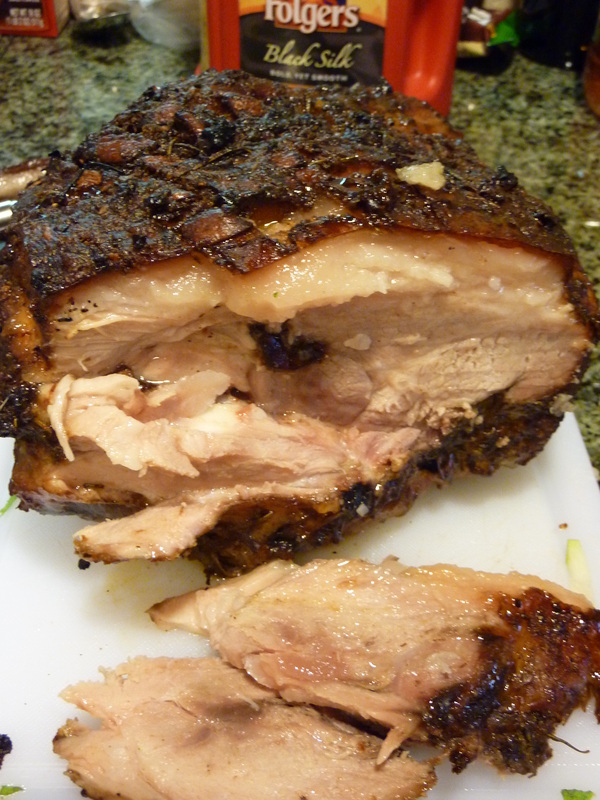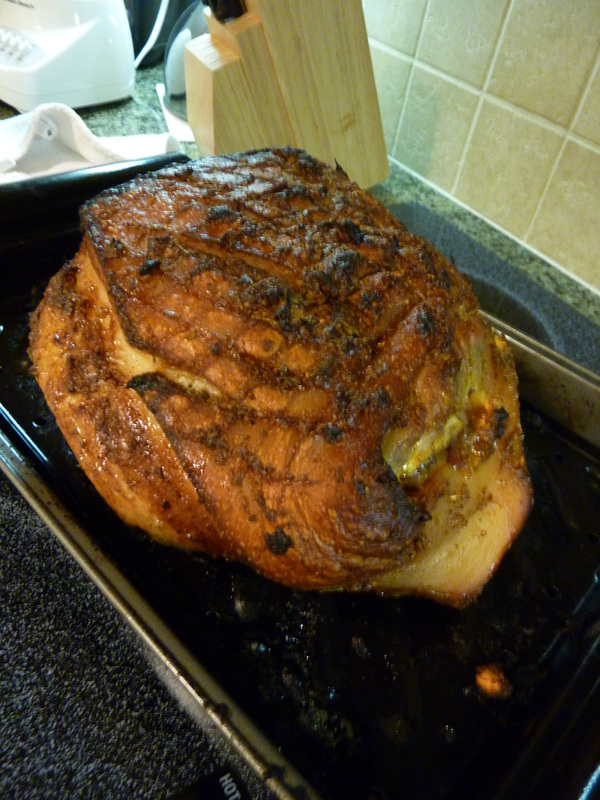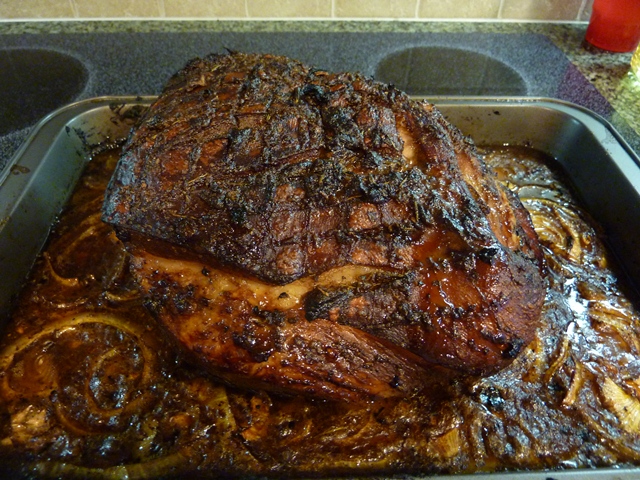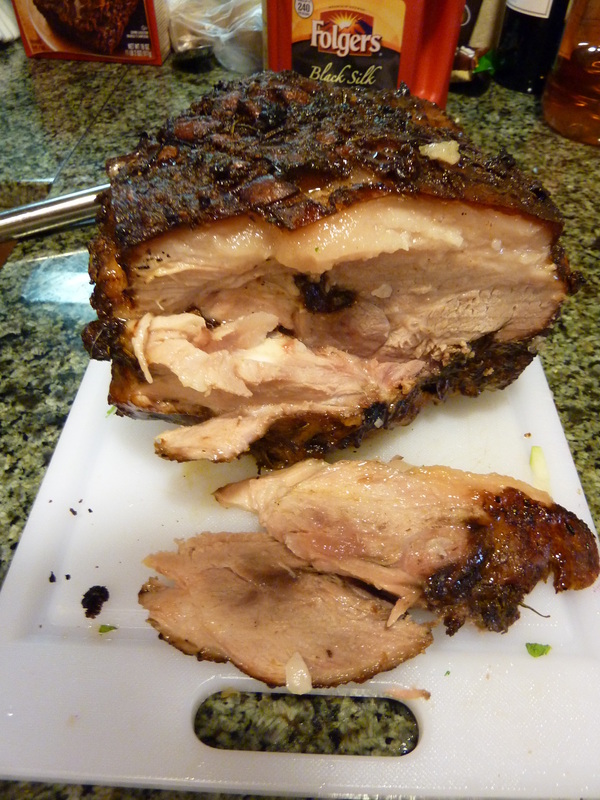Pork is a King among meats. It lords over venison with its superior fat content, rules over chicken with its more distinguished flavour. Beef and lamb are but peasants to it, be it suckling piglet or hoary boar. Game birds pay homage to the majesty of its crackling and goat, mutton, hoggart and kid are the humblest of subjects to its sausage. Besides, how could any animal that produces bacon be anything but a King.
I like pork in all its cuts and cooked in all sorts of ways. Am sure you do too. If you don’t…well, awkward.
This recipe is for slow roast pork shoulder. Shoulder is a great cut for long roasting because it has a high fat content. When cooked for extended periods the fat renders, penetrates the surrounding meat and infuses it with moisture and flavour. Cooking for a long time at a low temperature also results in meat that is extremely tender, having had longer to break down the muscle fibres. Try to buy a shoulder with the bone in still. Meat cooked on the bone tends to be much more flavoursome from precious minerals and fats that come out from the bone and the marrow during cooking. It also tends to be tenderer, less prone to drying out.
The recipe calls for the meat to first be put in the oven at a high temperature; this produces much loved, in my family anyway, crackling. The heat is then turned right down for 8-9 hours of long, slow roasting.
Anyway, enough from me. This tastes good.
I like pork in all its cuts and cooked in all sorts of ways. Am sure you do too. If you don’t…well, awkward.
This recipe is for slow roast pork shoulder. Shoulder is a great cut for long roasting because it has a high fat content. When cooked for extended periods the fat renders, penetrates the surrounding meat and infuses it with moisture and flavour. Cooking for a long time at a low temperature also results in meat that is extremely tender, having had longer to break down the muscle fibres. Try to buy a shoulder with the bone in still. Meat cooked on the bone tends to be much more flavoursome from precious minerals and fats that come out from the bone and the marrow during cooking. It also tends to be tenderer, less prone to drying out.
The recipe calls for the meat to first be put in the oven at a high temperature; this produces much loved, in my family anyway, crackling. The heat is then turned right down for 8-9 hours of long, slow roasting.
Anyway, enough from me. This tastes good.
Recipe
Ingredients (Serves 6-8):
1 7-8lb pork shoulder joint, skin on and bone in if possible. Allow to reach room temperature before cooking – this means that it will cook evenly and will start actually cooking from the minute you first put it in the oven, rather than staying cold in the centre and getting scorched on the outside.
1 head of garlic
5 spears of fresh rosemary, stems removed
2 teaspoons fresh thyme, stems removed
1/2 teaspoon garlic salt
1/2 teaspoon paprika
1 tablespoon salt
1/2 teaspoon black pepper
1 tablespoon wholegrain mustard
1 large white onion, sliced
1 large carrot or 2 small, chopped roughly
1 cup/250mls white wine
4 cups/ approx. 1 litre chicken stock
vegetable oil
Method:
1. Heat the oven to 450 Fahrenheit, 230 Celsius.
2. Take the pork shoulder, rinse it with water and pat dry. Score its skin/fat with diamond shapes, penetrating almost totally through the fat, but not penetrating the meat below itself.
3. Grind or process the rosemary, garlic, thyme, spices, salt and pepper and mustard into a paste. Add a little oil if you need to help it blend. Rub this paste all over the pork joint on all sides, getting it fully into the cracks of the fat, setting aside 1 teaspoon for later. Rub a bit of oil onto the skin too.
4. Place it into a roasting tray and roast in the oven for 45 minutes. The crackling should be nice and crisp and the joint should be dark brown, though not burnt, all over. Its scent should be intoxicating.
5. Remove from the oven. Turn the temperature down to 225 Fahrenheit/105ish Celsius.
6. Scatter the onions and carrot around the pork. Pour in the chicken stock and white wine and the teaspoon of the paste you saved from earlier. Baste the joint with this juice.
7. Return to the oven for 8-9 hours or until the pork is cooked through and tender. Its internal temperature, if you’re a meat thermometer kind of guy, should read 170-175 Fahrenheit. You can keep it warm in the oven by reducing the heat to 160 until you are ready to serve and it will keep good for a few hours like that. To make the fat extra crispy, remove from the joint with a knife, place on a tray and bake at 400 Fahrenheit/200 Celsius for around ten minutes. The meat should be tender, deeply browned, endlessly juicy and flavoursome.
8. To make a quick gravy, remove the joint from the roasting pan and set to one side. Set the pan over direct heat and heat on high until bubbling and reducing. Add a bit more wine if you like. Do this for around 7 minutes. Strain through a sieve and skim off the fat. Serve. Enjoy!
Ingredients (Serves 6-8):
1 7-8lb pork shoulder joint, skin on and bone in if possible. Allow to reach room temperature before cooking – this means that it will cook evenly and will start actually cooking from the minute you first put it in the oven, rather than staying cold in the centre and getting scorched on the outside.
1 head of garlic
5 spears of fresh rosemary, stems removed
2 teaspoons fresh thyme, stems removed
1/2 teaspoon garlic salt
1/2 teaspoon paprika
1 tablespoon salt
1/2 teaspoon black pepper
1 tablespoon wholegrain mustard
1 large white onion, sliced
1 large carrot or 2 small, chopped roughly
1 cup/250mls white wine
4 cups/ approx. 1 litre chicken stock
vegetable oil
Method:
1. Heat the oven to 450 Fahrenheit, 230 Celsius.
2. Take the pork shoulder, rinse it with water and pat dry. Score its skin/fat with diamond shapes, penetrating almost totally through the fat, but not penetrating the meat below itself.
3. Grind or process the rosemary, garlic, thyme, spices, salt and pepper and mustard into a paste. Add a little oil if you need to help it blend. Rub this paste all over the pork joint on all sides, getting it fully into the cracks of the fat, setting aside 1 teaspoon for later. Rub a bit of oil onto the skin too.
4. Place it into a roasting tray and roast in the oven for 45 minutes. The crackling should be nice and crisp and the joint should be dark brown, though not burnt, all over. Its scent should be intoxicating.
5. Remove from the oven. Turn the temperature down to 225 Fahrenheit/105ish Celsius.
6. Scatter the onions and carrot around the pork. Pour in the chicken stock and white wine and the teaspoon of the paste you saved from earlier. Baste the joint with this juice.
7. Return to the oven for 8-9 hours or until the pork is cooked through and tender. Its internal temperature, if you’re a meat thermometer kind of guy, should read 170-175 Fahrenheit. You can keep it warm in the oven by reducing the heat to 160 until you are ready to serve and it will keep good for a few hours like that. To make the fat extra crispy, remove from the joint with a knife, place on a tray and bake at 400 Fahrenheit/200 Celsius for around ten minutes. The meat should be tender, deeply browned, endlessly juicy and flavoursome.
8. To make a quick gravy, remove the joint from the roasting pan and set to one side. Set the pan over direct heat and heat on high until bubbling and reducing. Add a bit more wine if you like. Do this for around 7 minutes. Strain through a sieve and skim off the fat. Serve. Enjoy!








